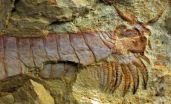(Press-News.org) An extraordinary find allowing scientists to see through the head of the 'fuxianhuiid' arthropod has revealed one of the earliest evolutionary examples of limbs used for feeding, along with the oldest nervous system to stretch beyond the head in fossil record.
Until now, all fossils found of this extremely early soft-bodied animal featured heads covered by a wide shell or 'carapace', obscuring underlying contents from detailed study.
But a new fossil-rich site in South China has been found to contain arthropod examples where the carapace has literally been 'flipped' over before fossilisation – allowing scientists to examine the fuxianhuiid head to an unprecedented extent.
The study, published today in Nature, highlights the discovery of previously controversial limbs under the head, used to shovel sediment into the mouth as the fuxianhuiid crawled across the seabed, millions of years before creatures emerged from the oceans.
Scientists say that this could be the earliest and simplest example of manipulative limbs used for feeding purposes, hinting at the adaptive ability that made arthropods so successful and abundant – evolving into the insects, spiders and crustaceans we know today.
Using a feeding technique scientist's call 'detritus sweep-feeding', fuxianhuiids developed the limbs to push seafloor sediment into the mouth in order to filter it for organic matter – such as traces of decomposed seaweed – which constituted the creatures' food.
Fossils also revealed the oldest nervous system on record that is 'post-cephalic' – or beyond the head – consisting of only a single stark string in what was a very basic form of early life compared to today.
"Since biologists rely heavily on organisation of head appendages to classify arthropod groups, such as insects and spiders, our study provides a crucial reference point for reconstructing the evolutionary history and relationships of the most diverse and abundant animals on Earth," said Javier Ortega-Hernández, from Cambridge's Department of Earth Sciences, who produced the research with Dr Nicholas Butterfield and colleagues from Yunnan University in Kunming, South China.
"This is as early as we can currently see into arthropod limb development."
Fuxianhuiids existed around 520 million years ago, roughly 50 million years before primordial land animals crawled from the sea, and would have been one of the first examples of complex animal life – likely to have evolved from creatures resembling worms with legs. Arthropods were the first jointed animals, enabling them to crawl.
Fuxianhuiid arthropods would have spent most of their time grazing on the sea floor, using these newly discovered limbs to plow sediment into their mouths. They could probably also use their bodies to swim for short distances, like tadpole shrimps.
The fossils date from the early part of the event known as the 'Cambrian explosion', when life on Earth went from multi-cellular organisms we know very little about to a relatively sudden and wide spread explosion of diverse marine animals - the first recognisable evolutionary step for the animal kingdom we know today.
"These fossils are our best window to see the most primitive state of animals as we know them – including us," said Ortega-Hernández. "Before that there is no clear indication in the fossil record of whether something was an animal or a plant – but we are still filling in the details, of which this is an important one."
While still a mystery, theories about the cause of the 'Cambrian Explosion' include possible correlations with oxygen rises, spikes in oceanic nutrient concentration, and genetic complexity reaching critical mass.
But the new site in South China where these fossils were found could prove to be key in uncovering ever more information about this pivotal period in the history of life on Earth. The Xiaoshiba 'biota' - that is the collection of all organisms preserved in the new locality - in China's Yunnan Province is similar to the world-famous Chengjiang biota, which provided many of the best arthropod fossil records to date.
"The Xiaoshiba biota is amazingly rich in such extraordinary fossils of early organisms," said Ortega-Hernández. "Over 50 specimens of fuxianhuiids have been found in just over a year, whereas previous areas considered fossil rich such as Chengjiang it took years - even decades - to build up such a collection."
"So much material is so well preserved. There's massive potential for Xiaoshiba to become a huge deal for new discoveries in early animal evolution".
INFORMATION:
For a copy of the paper and to speak to researchers, please contact:
Fred Lewsey, Cambridge communications office
+44 (0)1223 765566, 07885 798680, fred.lewsey@admin.cam.ac.uk
Feeding limbs and nervous system of one of Earth's earliest animals discovered
2013-02-28
ELSE PRESS RELEASES FROM THIS DATE:
What is the cost of rare diseases such as Friedreich's Ataxia?
2013-02-28
What is the cost of rare diseases such as Friedreich's Ataxia? By analyzing direct and indirect costs of care research in BioMed Central's open access journal Orphanet Journal of Rare Diseases calculated that conservatively this rare disease costs between £11,000 and £19,000 per person per year. Proper understanding resource allocation is important in minimizing the effect of Friedreich's Ataxia on people's lives while maximizing their quality of life.
Diseases are classified as 'rare' if they affect less than 1 in 2000 people. Lack of scientific knowledge means that ...
IV fluids used by NHS responsible for unnecessary deaths
2013-02-28
Starch-based intravenous (IV) fluids used by the NHS to treat seriously ill patients are causing unnecessary deaths, according to a new Cochrane systematic review by researchers at the London School of Hygiene & Tropical Medicine.
Based on data from 25 randomised control trials, the researchers concluded that starch-based colloid fluids, used to stabilise patients with low blood pressure, are not only more expensive than saline-based crystalloid fluids, but may also be causing around 250 unnecessary deaths in the UK every year.
The study included 9,147 seriously ill ...
Supermassive black hole spins super-fast
2013-02-28
Imagine a sphere more than 2 million miles across - eight times the distance from Earth to the Moon - spinning so fast that its surface is traveling at nearly the speed of light. Such an object exists: the supermassive black hole at the center of the spiral galaxy NGC 1365.
Astronomers measured its jaw-dropping spin rate using new data from the Nuclear Spectroscopic Telescope Array, or NuSTAR, and the European Space Agency's XMM-Newton X-ray satellites.
"This is the first time anyone has accurately measured the spin of a supermassive black hole," said lead author Guido ...
Silver nanoparticles may adversely affect environment
2013-02-28
DURHAM, N.C. -- In experiments mimicking a natural environment, Duke University researchers have demonstrated that the silver nanoparticles used in many consumer products can have an adverse effect on plants and microorganisms.
Fifty days after scientists applied a single low dose of silver nanoparticles, the experimental environments produced about a third less biomass in some plants and microbes.
These preliminary findings are important, the researchers said, because little is known about the environmental effects of silver nanoparticles, which are found in textiles, ...
Research explores factors that impact adolescent mental health
2013-02-28
Research indicates that half of all lifetime cases of mental illness begin by age 14, well before adulthood. Three new studies investigate the cognitive, genetic and environmental factors that may contribute to mental health disorders in adolescence. The studies are published in Psychological Science and Clinical Psychological Science, journals of the Association for Psychological Science.
Social-Information-Processing Patterns Mediate the Impact of Preventive Intervention on Adolescent Antisocial Behavior
Kenneth A. Dodge, Jennifer Godwin, and The Conduct Problems ...
NuSTAR helps solve riddle of black hole spin
2013-02-28
An international team including Lawrence Livermore National Laboratory scientists has definitively measured the spin rate of a supermassive black hole for the first time.
The findings, made by the two X-ray space observatories, NASA's Nuclear Spectroscopic Telescope Array (NuSTAR) and the European Space Agency's XMM-Newton, solve a long-standing debate about similar measurements in other black holes and will lead to a better understanding of how black holes and galaxies evolve.
"We can trace matter as it swirls into a black hole using X-rays emitted from regions very ...
First grade math skills set foundation for later math ability
2013-02-28
Children who failed to acquire a basic math skill in first grade scored far behind their peers by seventh grade on a test of the mathematical abilities needed to function in adult life, according to researchers supported by the National Institutes of Health.
The basic math skill, number system knowledge, is the ability to relate a quantity to the numerical symbol that represents it, and to manipulate quantities and make calculations. This skill is the basis for all other mathematics abilities, including those necessary for functioning as an adult member of society, a ...
A game plan for climate change
2013-02-28
Researchers have successfully piloted a process that enables natural resource managers to take action to conserve particular wildlife, plants and ecosystems as climate changes.
The Adaptation for Conservation Targets (ACT) framework is a practical approach to assessing how future changes in air and water temperatures, precipitation, stream flows, snowpack, and other environmental conditions might affect natural resources. ACT enables scientists and managers to work hand-in-hand to consider how management actions may need to be adjusted to address those impacts.
"As ...
Changing shape makes chemotherapy drugs better at targeting cancer cells
2013-02-28
(Santa Barbara, Calif. –) Bioengineering researchers at University of California, Santa Barbara have found that changing the shape of chemotherapy drug nanoparticles from spherical to rod-shaped made them up to 10,000 times more effective at specifically targeting and delivering anti-cancer drugs to breast cancer cells.
Their findings could have a game-changing impact on the effectiveness of anti-cancer therapies and reducing the side effects of chemotherapy, according to the researchers. Results of their study were published recently in Proceedings of the National Academy ...
Retailers should re-size maternity wear for women throughout their pregnancies, MU study finds
2013-02-28
COLUMBIA, Mo. — Fashion retailers have seen an increase in demand for maternity wear in recent years, as sales for maternity clothing have increased while overall women's apparel sales have declined. Currently, most retailers produce maternity wear using a standardized size chart that begins with women in their seventh month of pregnancy. Retailers produce garments for women who are earlier in their terms by adjusting the sizes smaller proportionally based on the standardized chart. In a recent study, University of Missouri researcher MyungHee Sohn, an assistant professor ...




